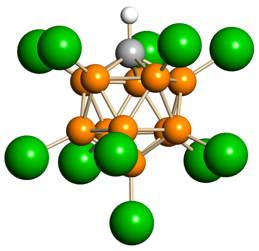Covering all the elements of the periodic table and underlying almost all modern technologies, inorganic chemistry offers unparalleled research diversity. UCR has unique research strengths in inorganic chemistry. From novel porous solids and nanostructured materials to the self-assembled cage receptor molecules and new catalysts, excitement and discovery awaits the curious student. Our faculty have vibrant collaborations with Physical and Analytical Chemists as well as materials scientists and engineers. Please follow the links below to learn more about the inorganic chemistry program at UCR.
Faculty Research Descriptions:
Matthew Conley
The goal of our research is to develop a molecular understanding of the active sites of heterogeneous catalysts. In order to study these catalysts at this level of detail we apply an interdisciplinary strategy that combines material synthesis, surface science, and synthetic inorganic chemistry. Our approach involves the preparation of high surface area materials containing characteristic surface sites that react with inorganic complexes to form metal sites with well-defined coordination spheres. This allows us to optimize the activity of heterogeneous catalysts based on the molecular structure of the active site, which we determine by spectroscopic techniques, and to study the key mechanistic steps in the catalytic cycle. We design the active sites in these catalysts to tackle challenging catalytic problems, such as the activation of C-H bonds to promote reactions relevant to commodity chemical production and the activation of small molecules for alternative energy applications.
Pingyun Feng
Solid State Materials, Inorganic Chemistry and Nanostructured Materials.Our research interest centers on the development of synthetic methodologies to prepare novel nanostructured materials and porous materials with applications in photocatalysis, catalysis, chemical separation, gas adsorption, and battery applications.
Boniface Fokwa
The Fokwa research group is interested in novel inorganic solids derived from the combination of main group elements and metals (mainly transition metals). Much emphasis lies on the elucidation of the crystal and electronic structures as well as structure-bonding-property correlations of such new compounds, thus enabling their potential applications as materials for energy related technologies (magnetic, magnetocaloric, superconducting and spintronic materials) as well as refractory materials (hard and superhard materials) and catalysts.
Hill Harman
Synthetic Inorganic, Organometallic and Organic chemistry: ligand and catalyst design; organocatalysis; electrocatalysis; structure, bonding, and reactivity of the transition and main group metals; energy and green chemistry.
Richard Hooley
Synthetic Organic, Inorganic and Supramolecular chemistry. Our projects include: the synthesis of biomimetic supramolecular constructs capable of selective molecular recognition; synthesis of new water-soluble catalysts and host molecules; dynamic NMR studies of host guest interactions; biosensors based on synthetic receptor molecules.
Catharine Larsen
Organic and Organometallic chemistry; discovery of new multicomponent metal-mediated reactions and their applications to the synthesis of complex molecules.
Vince Lavallo
Synthetic Organometallic, Inorganic and Organic chemistry. The preparation of novel transition metal and non-metallic catalysts for a variety of industrially important chemical transformations. Ligand design, asymmetric catalysis, new reaction methodology and carborane chemistry.
Samuel Mann
The Mann lab aims to merge (bio)inorganic chemical principles with protein design to construct new metalloproteins from scratch that help build structure-function relationships for natural metalloproteins and develop design principles for new-to-nature function. Our interests revolve around preparing and understanding reactive intermediates within our protein scaffolds and how to control reaction specificity at a metal center.
Timothy Su
Inorganic -focused projects in the Su Lab Involve the chemical synthesis and electronic study of silicon cluster compounds. We are exploring methods and mechanisms of their synthesis, their use as superatom building blocks in extended materials, and their fundamental quantum electronic transport properties.
Yadong Yin
Inorganic nanostructured materials. The Yin group is interested in the development of functional inorganic nanostructured materials for photonic, electronic, catalytic, bioanalytical, environmental and energy applications. Our unique tools for fabricating novel nanostructured materials include colloidal chemical synthesis, surface functionalization, and self-assembly techniques. The specific examples of applications of our materials include sensors and detectors, supercapacitors and batteries, smart materials, photocatalysts, color display devices, and anti-counterfeiting features.

